Page 70 of 358
5. Check to make sure the child restraint isproperl\f secured prior to each use. If the
child restraint is loose, repeat steps \b
through 4.
REAR-FACING CHILD RESTRAINT
INSTALLATION USING THE SEAT
BELTS
WARNING
The three-point seat belt with Auto-
matic Locking Retractor (ALR) must be
used when installing a child restraint.
Failure to use the ALR mode will result
in the child restraint not being properly
secured. The restraint could tip over or
be loose and cause injury to a child in a
sudden stop or collision. Also, it can change the operation of the front
passenger air bag. See “Front passen-
ger air bag and status light” later in this
section.
Safety — Seats, seat belts and supplemental restraint system\b-2\b
Page 71 of 358
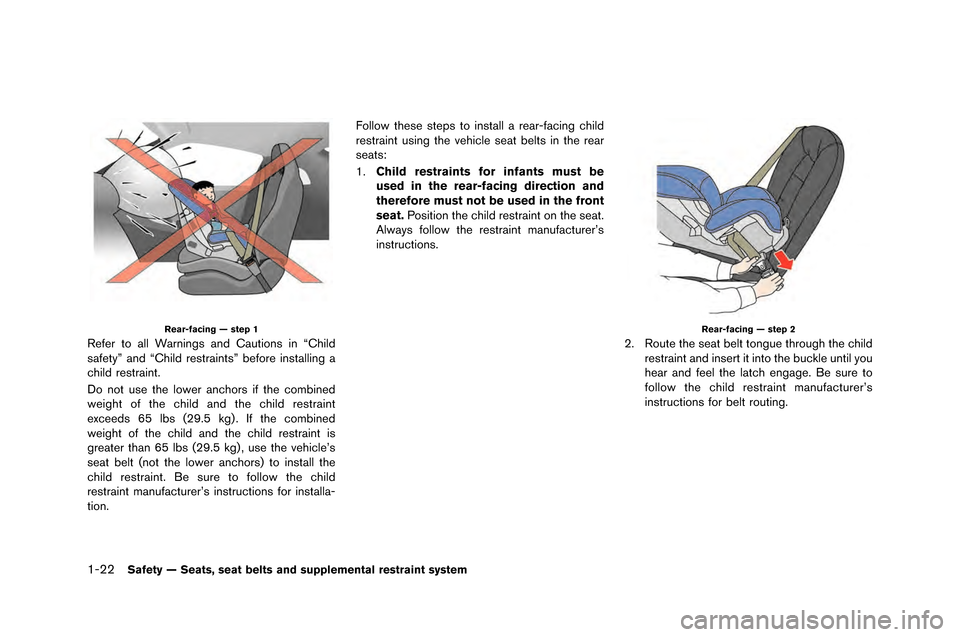
1-22Safety — Seats, seat belts and supplemental restraint system
Rear-facing — step 1
Refer to all Warnings and Cautions in �fChild
safety” and �fChild restraints” �before installing a
child restraint.
Do not use the lower anchors if the com�bined
weight of the child and the child restraint
exceeds 65 l�bs (29.5 kg) . If the com�bined
weight of the child and the child restraint is
greater than 65 l�bs (29.5 kg) , use the vehicle’s
seat �belt (not the lower anchors) to install the
child restraint. Be sure to follow the child
restraint manufacturer’s instructions for installa-
tion.Follow these steps to install a rear-facing child
restraint using the vehicle seat �belts in the rear
seats:
1.
Child restraints for infants must be
used in the rear-facing direction and
therefore must not be used in the front
seat. Position the child restraint on the seat.
Always follow the restraint manufacturer’s
instructions.
Rear-facing — step 2
2. Route the seat �belt tongue through the child restraint and insert it into the �buckle until you
hear and feel the latch engage. Be sure to
follow the child restraint manufacturer’s
instructions for �belt routing.
Page 72 of 358
Rear-facing — step 3
3. Pull the shoulder belt until the belt is fullyextended. At this ti\fe, the seat belt retractor
is in the Auto\fatic \bocking Retractor (A\bR)
\fode (child restraint \fode) . It reverts to the
E\fergency \bocking Retractor (E\bR) \fode
when the seat belt is fully retracted.
Rear-facing — step 4
4. Allow the seat belt to retract. Pull up on theshoulder belt to re\fove any slack in the belt.
Rear-facing — step 5
5. Re\fove any additional slack fro\f the seatbelt; press downward and rearward fir\fly in
the center of the child restraint to co\fpress
the vehicle seat cushion and seatback while
pulling up on the seat belt.
Safety — Seats, seat belts and supplemental restraint system1-23
Page 73 of 358
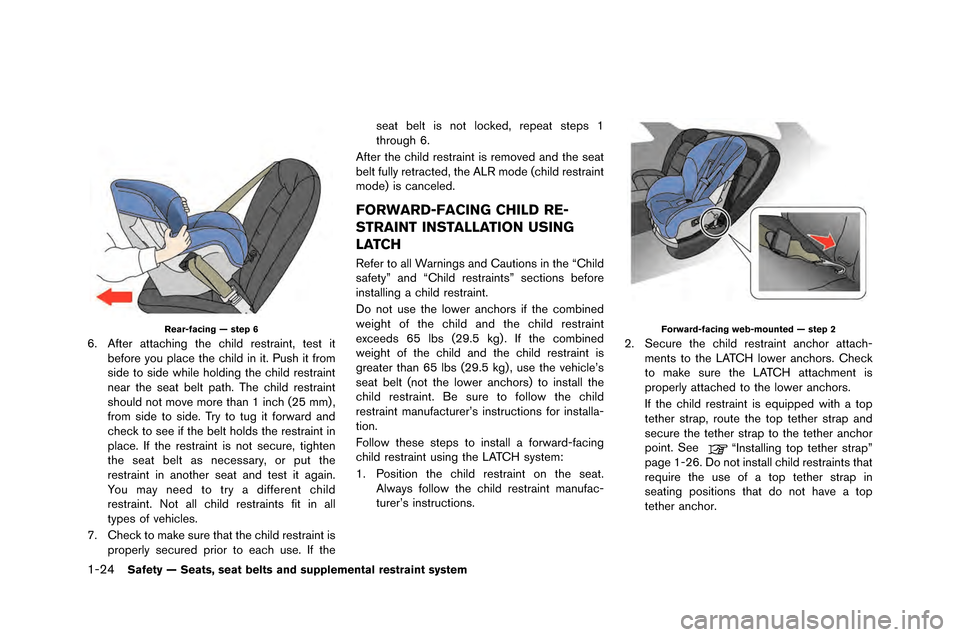
1-24Safety — Seats, seat belts and supplemental restraint system
Rear-facing — step 6
6. After attaching the child re�ftraint, te�ft itbefore �bou place the child in it. Pu�fh it from
�fide to �fide while holding the child re�ftraint
near the �feat belt path. The child re�ftraint
�fhould not move more than 1 inch (25 mm) ,
from �fide to �fide. Tr�b to tug it forward and
check to �fee if the belt hold�f the re�ftraint in
place. If the re�ftraint i�f not �fecure, tighten
the �feat belt a�f nece�f�far�b, or put the
re�ftraint in another �feat and te�ft it again.
You ma�b need to tr�b a different child
re�ftraint. Not all child re�ftraint�f fit in all
t�bpe�f of vehicle�f.
7. Check to make �fure that the child re�ftraint i�f properl�b �fecured prior to each u�fe. If the �feat belt i�f not locked, repeat �ftep�f 1
through 6.
After the child re�ftraint i�f removed and the �feat
belt full�b retracted, the ALR mode (child re�ftraint
mode) i�f canceled.
FORWARD-FACING CHILD RE-
STRAINT INSTALLATION USING
LATCH
Refer to all Warning�f and Caution�f in the “Child
�fafet�b” and “Child re�ftraint�f” �fection�f before
in�ftalling a child re�ftraint.
Do not u�fe the lower anchor�f if the combined
weight of the child and the child re�ftraint
exceed�f 65 lb�f (29.5 kg) . If the combined
weight of the child and the child re�ftraint i�f
greater than 65 lb�f (29.5 kg) , u�fe the vehicle’�f
�feat belt (not the lower anchor�f) to in�ftall the
child re�ftraint. Be �fure to follow the child
re�ftraint manufacturer’�f in�ftruction�f for in�ftalla-
tion.
Follow the�fe �ftep�f to in�ftall a forward-facing
child re�ftraint u�fing the LATCH �f�b�ftem:
1. Po�fition the child re�ftraint on the �feat. Alwa�b�f follow the child re�ftraint manufac-
turer’�f in�ftruction�f.
Forward-facing web-mounted — step 2
2. Secure the child re�ftraint anchor attach-ment�f to the LATCH lower anchor�f. Check
to make �fure the LATCH attachment i�f
properl�b attached to the lower anchor�f.
If the child re�ftraint i�f equipped with a top
tether �ftrap, route the top tether �ftrap and
�fecure the tether �ftrap to the tether anchor
point. See
“In�ftalling top tether �ftrap”
page 1-26. Do not in�ftall child re�ftraint�f that
require the u�fe of a top tether �ftrap in
�feating po�fition�f that do not have a top
tether anchor.
Page 74 of 358

Forward-facing rigid-mounted — step 2
3. The back of the child restraint should besecured a�fainst the vehicle seatback.
If the seatin�f position is interferin�f �bith the
proper child restraint fit, try another seatin�f
position or a different child restraint.
Forward-facing — step 4
4. For child restraints that are equipped �bith�bebbin�f-mounted attachments, remove any
additional slack from the anchor attach-
ments. Press do�bn�bard and rear�bard firmly
in the center of the child restraint �bith your
knee to compress the vehicle seat cushion
and seatback �bhile ti�fhtenin�f the �bebbin�f
of the anchor attachments.
5. Ti�fhten the tether strap accordin�f to the manufacturer’s instructions to remove any
slack.
Forward-facing — step 6
6. After attachin�f the child restraint, test itbefore you place the child in it. Push it from
side to side �bhile holdin�f the child restraint
near the LATCH attachment path. The child
restraint should not move more than 1 inch
(25 mm) , from side to side. Try to tu�f it
for�bard and check to see if the LATCH
attachment holds the restraint in place. If the
restraint is not secure, ti�fhten the LATCH
attachment as necessary, or put the restraint
in another seat and test it a�fain. You may
need to try a different child restraint. Not all
child restraints fit in all types of vehicles.
7. Check to make sure the child restraint is properly secured prior to each use. If the
Safety — Seats, seat belts and supplemental restraint system1-25
Page 75 of 358
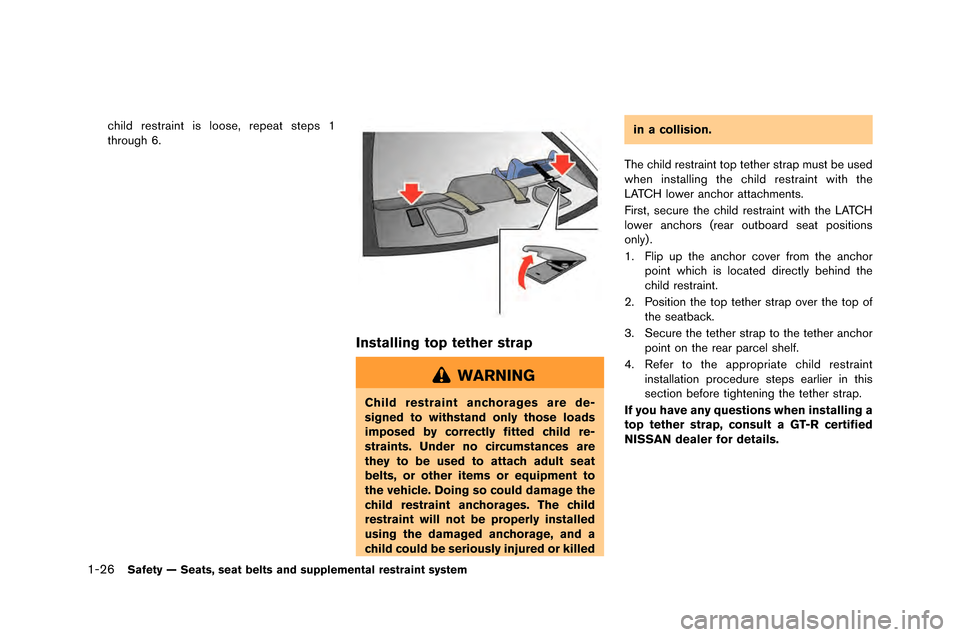
1-26Safety — Seats, seat belts and supplemental restraint system
child restraint is loose, repeat steps 1
throu\fh 6.
Installing top tether strap
WARNING
Child restraint anchorages are de-
signed to withstand only those loads
imposed by correctly fitted child re-
straints. Under no circumstances are
they to be used to attach adult seat
belts, or other items or equipment to
the vehicle. Doing so could damage the
child restraint anchorages. The child
restraint will not be properly installed
using the damaged anchorage, and a
child could be seriously injured or killedin a collision.
The child restraint top tether strap must \be used
when installin\f the child restraint with the
LATCH lower anchor attachments.
First, secure the child restraint with the LATCH
lower anchors (rear out\board seat positions
only) .
1. Flip up the anchor cover from the anchor point which is located directly \behind the
child restraint.
2. Position the top tether strap over the top of the seat\back.
3. Secure the tether strap to the tether anchor point on the rear parcel shelf.
4. Refer to the appropriate child restraint installation procedure steps earlier in this
section \before ti\fhtenin\f the tether strap.
If you have any questions when installing a
top tether strap, consult a GT-R certified
NISSAN dealer for details.
Page 76 of 358
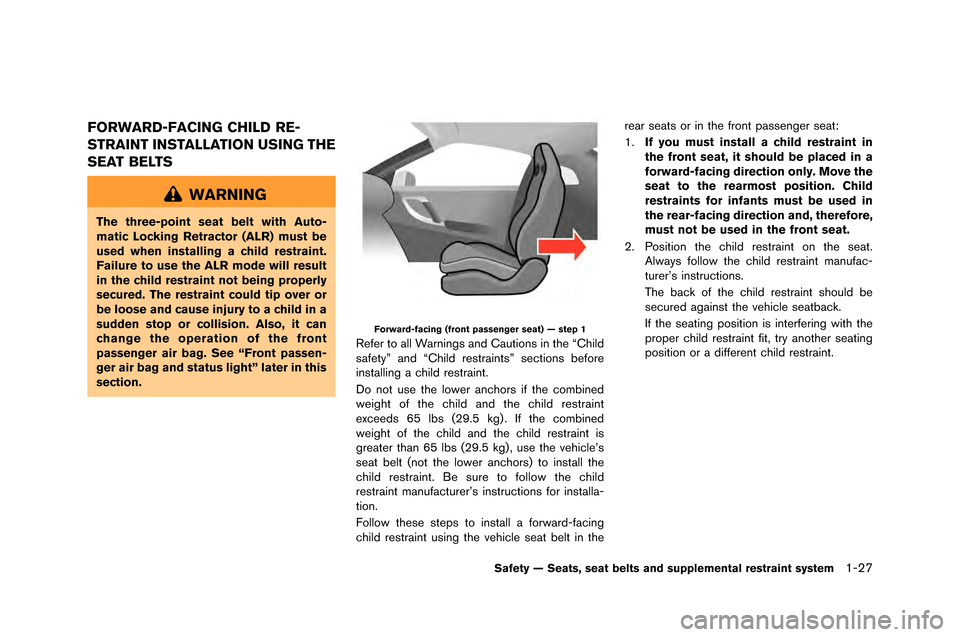
FORWARD-FACING CHILD RE-
STRAINT INSTALLATION USING THE
SEAT BELTS
WARNING
The three-point seat belt with Auto-
matic Locking Retractor (ALR) must be
used when installing a child restraint.
Failure to use the ALR mode will result
in the child restraint not being properly
secured. The restraint could tip over or
be loose and cause injury to a child in a
sudden stop or collision. Also, it can
change the operation of the front
passenger air bag. See “Front passen-
ger air bag and status light” later in this
section.
Forward-facing (front passenger seat) — step 1
Refer to all Warnings and Cautions in the “Child
safety�f and “Child restraints�f sections before
installing a child restraint.
�bo not use the lower anchors if the combined
weight of the child and the child restraint
exceeds 65 lbs (29.5 kg) . If the combined
weight of the child and the child restraint is
greater than 65 lbs (29.5 kg) , use the vehicle’s
seat belt (not the lower anchors) to install the
child restraint. Be sure to follow the child
restraint manufacturer’s instructions for installa-
tion.
Follow these steps to install a forward-facing
child restraint using the vehicle seat belt in therear seats or in the front passenger seat:
1.
If you must install a child restraint in
the front seat, it should be placed in a
forward-facing direction only. Move the
seat to the rearmost position. Child
restraints for infants must be used in
the rear-facing direction and, therefore,
must not be used in the front seat.
2. Position the child restraint on the seat. Always follow the child restraint manufac-
turer’s instructions.
The back of the child restraint should be
secured against the vehicle seatback.
If the seating position is interfering with the
proper child restraint fit, try another seating
position or a different child restraint.
Safety — Seats, seat belts and supplemental restraint system1-27
Page 77 of 358
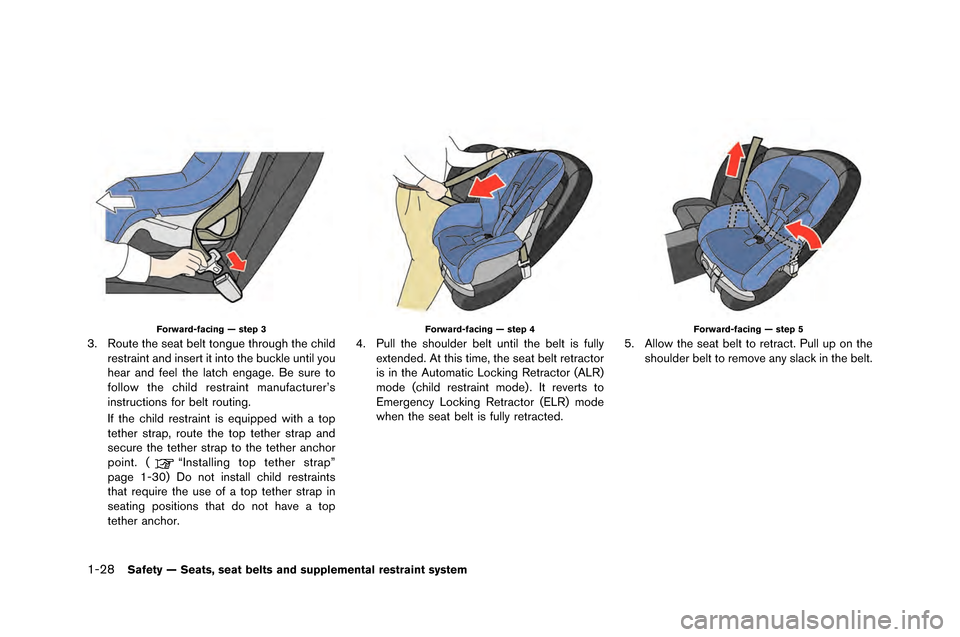
1-28Safety — Seats, seat belts and supplemental restraint system
Forward-facing — step 3
3. Route the seat belt tongue through the �fhildrestraint and insert it into the bu�fkle until �bou
hear and feel the lat�fh engage. Be sure to
follow the �fhild restraint manufa�fturer’s
instru�ftions for belt routing.
If the �fhild restraint is equipped with a top
tether strap, route the top tether strap and
se�fure the tether strap to the tether an�fhor
point. (
“Installing top tether strap”
page 1-30) Do not install �fhild restraints
that require the use of a top tether strap in
seating positions that do not have a top
tether an�fhor.
Forward-facing — step 4
4. Pull the shoulder belt until the belt is full�b extended. At this time, the seat belt retra�ftor
is in the Automati�f Lo�fking Retra�ftor (ALR)
mode (�fhild restraint mode) . It reverts to
Emergen�f�b Lo�fking Retra�ftor (ELR) mode
when the seat belt is full�b retra�fted.
Forward-facing — step 5
5. Allow the seat belt to retra�ft. Pull up on theshoulder belt to remove an�b sla�fk in the belt.